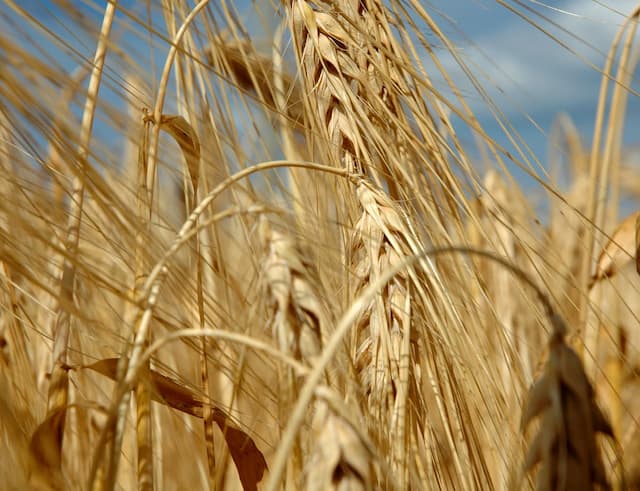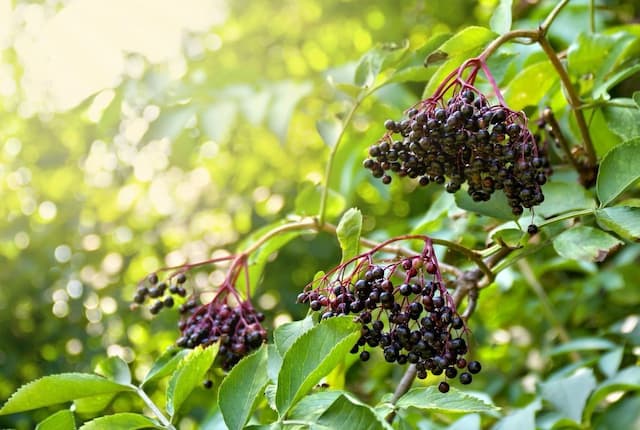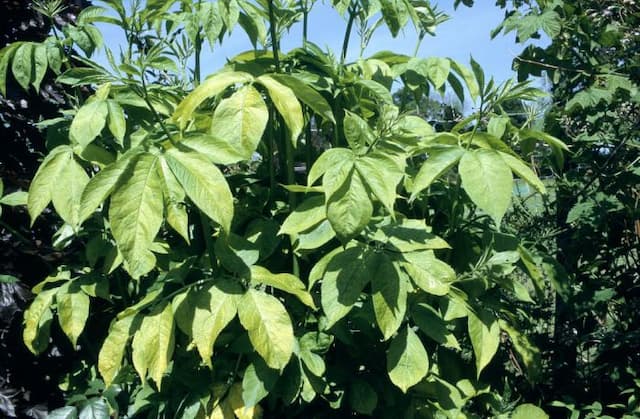Japanese Snowball Viburnum plicatum f. plicatum 'Popcorn'

ABOUT
The Viburnum 'Popcorn' is a visually charming shrub that is noted for its distinctive floral display that resembles popcorn. In spring, the branches are adorned with many snowball-like clusters of creamy white flowers that stand out against the plant's green foliage. These blooms are comprised of numerous small flowers tightly packed together, creating a delightful, fluffy appearance. The leaves of this shrub are equally impressive—deep green, with a pronounced texture that looks as if they were deeply crinkled or pleated, hence the name "plicatum." As the seasons change, the foliage may turn to a reddish-purple, adding a touch of autumn color to the landscape. The plant's structure is also pleasing; it has a horizontal branching habit that gives it a layered look, making it an attractive addition to any garden space as a visual feature throughout the year.
About this plant
 Names
NamesSynonyms
Japanese Snowball, Popcorn Viburnum.
Common names
Viburnum plicatum f. tomentosum 'Popcorn'.
 Toxicity
ToxicityTo humans
The Japanese Snowball plant is generally considered not toxic to humans. However, consuming a large amount of any plant material may cause some stomach upset or discomfort due to the fibrous plant matter.
To pets
The Japanese Snowball plant is also considered non-toxic to pets. Like with humans, ingestion of plant parts in large quantities might result in gastrointestinal upset such as vomiting or diarrhea, but it is not known to be poisonous to pets.
 Characteristics
CharacteristicsLife cycle
Perennials
Foliage type
Deciduous
Color of leaves
Green
Flower color
White
Height
4-5 feet (1.2-1.5 meters)
Spread
4-6 feet (1.2-1.8 meters)
Plant type
Shrub
Hardiness zones
5
Native area
Asia
Benefits
 General Benefits
General Benefits- Aesthetic Appeal: The 'Popcorn' viburnum showcases attractive clusters of white flowers that resemble popcorn, which bloom profusely in spring, enhancing garden beauty.
- Seasonal Interest: It offers year-round visual interest with its flowers in spring, lush green foliage in summer, and potentially red leaves or berries in autumn.
- Landscape Versatility: This shrub can be used in a variety of landscape designs, including as a specimen plant, hedge, or part of a mixed border.
- Wildlife Attraction: The blooms can attract pollinators like butterflies, while the berries, if produced, may attract birds, contributing to local biodiversity.
- Low Maintenance: Once established, the 'Popcorn' viburnum is low maintenance, requiring minimal care beyond occasional pruning and watering.
- Drought Tolerance: It is relatively resistant to drought, making it suitable for gardens in areas with limited rainfall once it is established.
- Frost Resistance: The plant is hardy and can tolerate frosts, making it suitable for cooler climates.
 Medical Properties
Medical PropertiesThis plant is not used for medical purposes.
 Air-purifying Qualities
Air-purifying QualitiesThis plant is not specifically known for air purifying qualities.
 Other Uses
Other Uses- Viburnum plicatum 'Popcorn' can be used in bonsai cultivation, as its structure and leaf shape offer aesthetic appeal in miniature form.
- The strong, straight branches of 'Popcorn' can be harvested and used in floral arrangements, providing a sturdy and attractive framework.
- The dense foliage offers a natural privacy screen when planted in rows or as part of a hedgerow in landscaping designs.
- Its leaves change color in the autumn, providing seasonal interest in the garden; these fallen leaves can also be collected and used to create natural mulch.
- With its layered, horizontal branches, 'Popcorn' can be included in garden designs to emulate the traditional Japanese gardening technique of "Niwaki".
- The rough texture of the bark may be used for educational purposes, such as teaching about different types of tree bark in botany classes.
- The plant's robust form can act as a windbreak in gardens, helping to protect more delicate plants from strong winds.
- In craft activities, the dried flowers of 'Popcorn' can be painted and used for decoration or as part of homemade potpourris.
- Its dense growth habit provides valuable habitat for birds, who might nest among the branches or eat the berries in winter.
- For outdoor photography, the plant’s pronounced bloom period provides an excellent backdrop for spring-themed portraits.
Interesting Facts
 Feng Shui
Feng ShuiThe Japanese Snowball is not used in Feng Shui practice.
 Zodiac Sign Compitability
Zodiac Sign CompitabilityThe Japanese Snowball is not used in astrology practice.
 Plant Symbolism
Plant Symbolism- Rebirth: The 'Popcorn' Viburnum bursts into bloom in spring, symbolizing new beginnings and the awakening of nature after winter dormancy.
- Innocence: The pure white flowers of this plant can symbolize innocence and purity, reminiscent of its popcorn-like blossoms.
- Abundance: With its lush, abundant flowers, the 'Popcorn' Viburnum may represent growth, fertility, and the concept of thriving in life's various aspects.
- Protection: Historically, some Viburnum species have been planted for their protective qualities, safeguarding against negative influences and fostering a sense of security.
- Connection to nature: As a flowering shrub, the 'Popcorn' Viburnum is often associated with a deep connection to the natural world and an appreciation for its beauty.
 Water
WaterFor the Japanese Snowball 'Popcorn', water deeply and thoroughly to encourage strong root development. It's best to water the Japanese Snowball once a week during the first growing season to establish a deep, extensive root system. Depending on the climate and soil type, adjust the frequency; sandy soils require more frequent watering than clay soils. Ensure at least 1-1.5 inches of water per week, either from rainfall or supplemental watering. During the hot, dry summer months, increase watering, but once the plant is established, it's relatively drought-tolerant and may need less frequent watering.
 Light
LightThe Japanese Snowball 'Popcorn' thrives in full sun to partial shade. The ideal location receives morning sunlight and afternoon shade to protect it from the intense heat of the day. However, it's adaptable and can still perform well in areas with more significant amounts of shade, though too much shade can reduce flowering.
 Temperature
TemperatureJapanese Snowball 'Popcorn' prefers a temperate climate and can generally tolerate temperatures down to 20 degrees Fahrenheit and up to 85 degrees Fahrenheit. The ideal temperature range for robust growth and flowering is between 60 and 75 degrees Fahrenheit. It's important to protect the plant from harsh winter winds and excessively high temperatures.
 Pruning
PruningPrune the Japanese Snowball 'Popcorn' to maintain shape and remove any dead or diseased branches, as well as to promote a more robust structure. It is best to prune immediately after flowering since the plant blooms on old wood. Pruning can be done annually, and any heavy cutting should be reserved for the dormant season.
 Cleaning
CleaningAs needed
 Soil
SoilJapanese Snowball 'Popcorn' thrives in moist, well-draining soil enriched with organic matter. A mix including peat, compost, and perlite would suit it well. It prefers a soil pH of 5.6 to 6.6.
 Repotting
RepottingJapanese Snowball 'Popcorn' should be repotted every 3-5 years to refresh the soil and to accommodate root growth.
 Humidity & Misting
Humidity & MistingJapanese Snowball 'Popcorn' is tolerant of a range of humidity levels but does best with average to high humidity.
 Suitable locations
Suitable locationsIndoor
Place in bright, indirect light; water when top soil feels dry.
Outdoor
Full sun to partial shade; shelter from strong winds; mulch root zone.
Hardiness zone
5-8 USDA
 Life cycle
Life cycleViburnum plicatum 'Popcorn', commonly called Japanese Snowball Viburnum, begins its life cycle as a dormant seed that, with proper conditions, germinates in late winter to early spring. After germination, the seedling grows into a young plant, developing a root system and foliage through the spring and summer. As it matures, this deciduous shrub forms a rounded shape with white, popcorn-like blooms in the spring, which are followed by reddish-black fruit. Throughout the summer, the plant continues to grow, both in height and spread, with its leaves transitioning from a deep green to burgundy in the fall. In autumn, after fruiting, the plant prepares for dormancy by dropping its leaves, conserving energy throughout the winter. Year after year, the plant will follow this cycle, flowering and growing, while also spreading through suckering if the conditions are favorable, gradually reaching its mature size of 8-10 feet tall and wide over several years.
 Propogation
PropogationPropogation time
Spring-Early Summer
The most popular method for propagating Viburnum plicatum f. plicatum 'Popcorn', commonly known as Doublefile Viburnum, is through softwood cuttings. This technique is typically performed in late spring or early summer when new growth is still tender and green. To propagate, one should take a cutting of about 4 to 6 inches (approximately 10 to 15 centimeters) in length from the current year's growth, ensuring that a few sets of leaves are present. The cut end should be dipped in rooting hormone to encourage root development and then planted in a well-draining potting mix. The cutting should be kept moist and in a warm, indirect light environment until roots have established, after which it can be transplanted to a more permanent location.



![Elder [Black Tower]](/_next/image?url=https%3A%2F%2Fplants-admin.emdemapps.com%2Fimages%2Fplants%2F%2Fimages%2F604b5cad99578.png&w=640&q=75)





